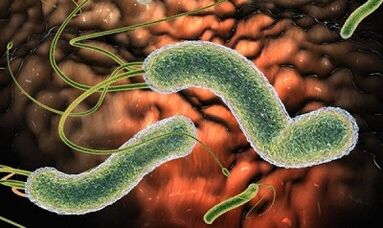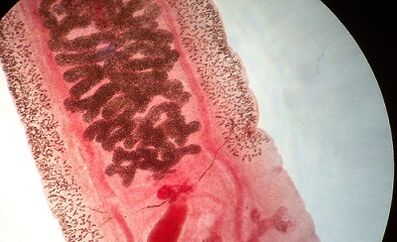
In patients, a serious misconception is that worms live only in the gut.However, it cannot be denied that parasites in human blood are as widespread as other types of Helminthias.The identification and timely treatment of this pathological state requires special attention, because when it enters the blood, a small socket can hit any organ.
The symptoms and feelings of pain that cause worms in human blood may vary in their manifestations and severity.It is important to start treatment in a timely manner and prevent further spread of parasites in the human body to prevent timely complex consequences.Initially, it is necessary to find out the appearance of worms in the blood.
Parasite type setting blood
There is nothing like a huge spread of the symptoms that appear in the blood.Various types of worms can cause different signs.If the worm is infected with blood or blood vessels, the patient will need a complete medical examination, which will help identify the type of parasite and determine the appropriate treatment of the pathological condition.
There are many parasites that can live in human blood:
- Pabusia;
- Malaria parasite;
- Tripanosoma;
- Ankylostoma;
- Trichinella;
- Toxoplasma gondii;
- Toksokara.
Most worms enter the body after insect bites.This parasite in the circulating channel is the most dangerous for children.They affect the proper development of organs, the growth of the entire organism and the state of the immune system.Many people can live with parasites for many years without even suspecting that they have been infected.
General symptoms of parasitic blood poisoning
Each individual parasite in human blood has symptoms that are only suitable for this disease.
However, any type of germ disease has many characteristics:
- weakness;
- Dizziness, headache;
- Nausea, vomiting;
- Can raise the overall temperature;
- Limb and whole body pain;
- Unconscious attacks are possible.
All these symptoms are the main manifestations of increased toxic substances in the body.First, it is necessary for them to contact the medical facility and the doctor will perform all necessary tests and diagnostic procedures, which will most accurately determine the cause of this state.
Babesiosis: Symptoms, diagnosis and treatment
Bebecia is a small parasite, and a ixodic tick enters the human body in one mouthful.These simplest organisms quickly penetrate the red blood cell membrane and begin a difficult life cycle.The disease is widely used in warm areas of ixodes clan mites.
In most cases, the disease has no obvious symptoms in adults and children.
However, when the disease develops and further develops, characteristics are noticed:
- hemolytic anemia;
- Fever to 39-40 degrees;
- Chills;
- Increase sweating.
Similar symptoms appear 4 weeks after the tick worm bite.After the incubation period, the chance of identifying the disease is higher.
The disease can only be diagnosed under specialized laboratory conditions.Therefore, there is not much data on the disease and its symptoms.
However, the attending physician should take many steps to identify the pathogenic aliens in the patient:
- General blood tests;
- Serological tests of female antibodies;
- polymerase chain reaction;
- Microscopic examination of blood smears (stained by hymns).
The treatment is mainly performed with antiphytosaccharides.Typically, the process of taking such funds lasts no more than 10 days, but can continue in patients with recurrent disease.Treatment of asymptomatic patients is only performed when the etiology of Babusiosis is detected in the blood during reexamination, which takes place several months after the initial test, when the disease occurs frequently.
Grade tertiary physical disease: symptoms, diagnosis, treatment

In countries with tropical and subtropical climates, the third-level heterogeneous phase, or a disease called drowsy, is widespread and rarely found in temperate latitudes.The pathogen of this disease is the trisomy.This is a small parasite.After viewing photos of the parasites made using electron microscopes, you can distinguish flagella from membranes along the entire length of the simplest body.
The disease and its symptoms develop throughout two entire stages.In the first stage, the parasite infiltrates the human red blood cells and begins to actively reproduce.
This stage can be recognized by the following symbols:
- Fever lasts up to 7 days;
- Headache, weakness;
- joint pain and limbs;
- Severe itching;
- The appearance of a red cabin in an inflamed lymph node area.
In the second stage of the disease, the tertiary body penetrates the central nervous system through the serum brain barrier.This stage is characterized by severe sleep and wakefulness cycles – the main symptoms of the disease.
In addition, during the second stage of the patient, it may occur:
- Confused consciousness;
- The muscles are trembling and weak;
- Paralyzed limbs;
- indifferent;
- irritability;
- Aggression related to others.
It is necessary to start treatment as soon as possible otherwise this is not the most favorable result.As the disease progresses, the disease immediately causes organ failures in several body systems, and the result is death of the patient.
The diagnosis of drowsy disease is based on patient symptoms and microbiological studies used to Trapanos in blood, lymph and suppurative fluid absorbed from Shancra.In positive samples, prescription treatment is urgently needed.
A good prognosis can be made when the disease is detected during the hemolysis stage.Currently, quite toxic drugs are prescribed, but overall, the patient's body can tolerate treatment well.
However, when the disease is only recognized in stage 2, the prognosis is not always comforting.To treat this pathological condition, it is necessary to use severely toxic drugs that can penetrate through the protective barrier of the central nervous system.
Malaria: Symptoms and Treatment

Plasmodium infection occurs through mosquito bites.The parasite penetrates into a person's blood through the female salivary glands and flows into the liver with blood, where the first stage of the perversion passes, then enters the bloodstream again and affects the red blood cells.
The incubation period of the disease lasts for up to 25 days.Then the first symptoms of malaria are shown:
- Body temperature rises sharply;
- Headache, weakness;
- hemolytic anemia;
- Skin yelled;
- Nausea, vomiting;
- joint pain, pain in the whole body;
- a twitching burst;
- The emergence of red blood cell destruction products in urine.
Basically, the disease is prevalent in warm and hot areas, so its diagnosis is based solely on the symptoms and medical history of the patient's life as shown over time.Frequent travel to equatorial countries can lead to the development of disease.In addition, standard blood tests and microbiological examinations were performed on body fluids.
Depending on the type of disease and its severity, prescription treatment is mainly performed with antimalarial drugs.
Ankylostomos: Symptoms, diagnosis and treatment
The parasites that cause the disease live in genes in the intestines and feed on the body's blood cells.The worms pass through a person's skin and begin to migrate into the intestine.During movement around the body, parasites with blood flow fall into the lungs and then pass along the trachea and bronchials in the upper respiratory tract, where they cause swallowing reflexes that extend into the intestine and secure on its walls.
On rare occasions, worms cannot successfully complete their migration and remain under one's skin.In the photo, a similar process resembles a small, thin snake under the patient's skin.

Eating blood, worms can stimulate the development of iron deficiency anemia in infected people.When worms penetrate a child's body, the most dangerous thing is.A lack of iron, protein and other essential ingredients to develop children can lead to mental depression, slow growth and physical inferiority.
The main symptoms of Ankylostomos:
- Iron deficiency anemia;
- fever;
- Abdominal pain;
- Nausea, vomiting;
- Diarrhea, constipation;
- Severe weight loss;
- Coughing, parasitic larval stage migration is possible in the upper respiratory tract.
Among the diagnostic measures, general blood tests, feces and urine analysis were performed on the digestive system.The identification of parasites serves as a sufficient reason to begin immediate treatment and prevention of pathological conditions associated with impaired respiratory, digestive and circulatory functions in the patient.
Treatment is performed by a one-time intake of deworming drugs.Supplementing vitamin and mineral complexes can smooth out the consequences of hemoglobin deficiency.
Toxic methods: symptoms and treatment
The cause of this disease is round worms, where a person communicates with pets that have not passed the worm while eating unwashed vegetables and fruits for a long time.The human body becomes the intermediate host of parasites.
Entering the intestine, the larvae hatch from the eggs, and then begins to "drill" the intestinal wall and penetrate into the blood.As the blood flows, the worms migrate into any system in the human body.The result of worm migration is severely damaged liver, heart, central nervous system and vision organs.

The main symptoms of human infection:
- Increase body temperature;
- The occurrence of severe abdominal pain;
- Weakness, dizziness;
- Allergic rashes appear on the skin;
- Strong cough at night;
- Twitching, muscle and joint pain.
Diagnosing a disease is very difficult.Severe microbiological tests are necessary and a special laboratory is required:
- polymerase chain reaction;
- Immunosorption analysis;
- Serological examination;
- Ultrasound examination of the organ;
- Magnetic resonance and computed tomography.
Severe deworming treatment is only performed when the patient's myocardium is severely damaged.Since the larval stage cannot develop into adults within the intermediate host, the disease often spreads independently.
However, it is necessary to consider the harm that migrating worms can cause patients.Supportive therapy is necessary and necessary measures are taken to prevent the development of severe pathological processes in the liver, cardiovascular and other organs.
in conclusion
Any parasite is dangerous to the human body.If you ask questions, “what parasites survive or use blood as a transport system,” “how to correctly determine it,” “how to treat them and what to accept,” it is better to contact the parasitologist rather than make independent decisions.The treatment and prevention of parasitic diseases are the decisions that qualified doctors should make.



























